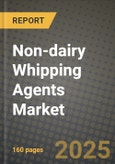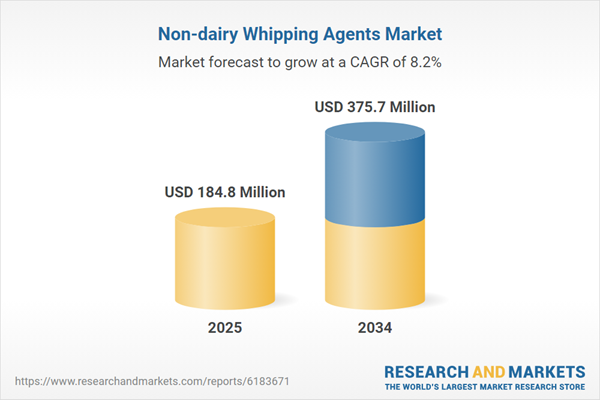Non-dairy Whipping Agents Market
The Non-dairy Whipping Agents Market centers on functional systems - typically blends of plant lipids, emulsifiers, proteins, and hydrocolloids - engineered to deliver aeration, overrun, and foam stability in toppings, mousses, cakes, pastries, beverages, and frozen desserts. Demand is propelled by bakery cafés, QSR dessert formats, home baking, and industrial patisserie where heat tolerance, pipeability, and freeze-thaw stability are critical. Top applications span ambient and chilled whipped toppings, cake decoration and filling, cream-inspired dessert bases, milkshakes/frappés, and soft-serve/ice-cream inclusions. Key trends include plant-forward and allergen-aware formulations (soy-free/pea-protein, oat/coconut fat systems), non-hydrogenated and palm-alternative lipids, clean-label emulsifier systems, and sugar-reduction with texture retention. Regulatory pressure on PHOs and evolving vegan claims underpin reformulations, while RSPO and deforestation-free commitments shape sourcing. Competitively, global ingredient houses and specialized bakery-solution players compete on whip time, firmness retention, heat shock resistance, and sensory parity with dairy. Powder pre-mixes for cost-effective logistics coexist with aseptic liquid concentrates for speed and consistency in commissaries and HORECA. Co-development with industrial bakers, private-label retailers, and foodservice chains accelerates adoption, supported by pilot bakeries and application labs. Volatility in vegetable oils and plant proteins, regional labeling nuances, and consumer perception of “E-numbers” influence pricing and portfolio strategy. Digitalization in bakeries, e-commerce patisserie growth, and automated whipping/dispensing equipment are expanding the addressable base, with sustainability credentials and stable performance in tropical supply chains emerging as decisive differentiators.Non-dairy Whipping Agents Market Key Insights
- Formulation shift to plant-forward systems
- Performance under thermal and mechanical stress
- Powder vs. liquid formats - logistics and consistency trade-offs
- Clean label and “E-number” perception management
- Sugar- and calorie-reduction without textural penalties
- Equipment compatibility and process robustness
- Regional lipid sourcing and sustainability claims
- Foodservice standardization and training at scale
- Private label and value engineering dynamics
- Application-lab partnerships and rapid commercialization
Non-dairy Whipping Agents Market Reginal Analysis
North America
Adoption is led by bakery-café chains, grocery in-store bakeries, and premium chilled desserts, with strong traction for non-hydrogenated and clean-label formats. Plant-based claims intersect with allergen management, prompting soy-free and pea-based systems that balance firmness with light mouthfeel. Foodservice emphasizes speed and consistency via aseptic liquids, especially for iced beverage toppings and bakery décor. Private-label expansion intensifies cost-performance scrutiny, while sustainability narratives around palm alternatives and transparent sourcing gain weight in retailer RFPs.Europe
Stringent label expectations and mature patisserie traditions drive emphasis on short ingredient lists, natural stabilizers, and sensory finesse. Sunflower and rapeseed-based lipid systems are preferred, with interest in palm-free and organic options. Artisan and industrial segments both value clean cut, glossy finish, and stability under glass displays. Continuous aeration equipment is widespread, pushing agents that tolerate narrow thermal windows. Retail chilled desserts and bakery counters anchor demand, with co-development focused on reduced-sugar SKUs that maintain volume and stand-up.Asia-Pacific
Rapid growth stems from modern trade bakery chains, convenience desserts, and beverage-led formats like frappés and milk teas. Tropical climates necessitate heat-shock resistance, fast whip, and strong foam films to endure delivery. Powder pre-mixes are favored for logistics and flexibility, while urban commissaries trial aseptic liquids. Cost management is pivotal amid volatility in palm, coconut, and pea protein; yet premiumization in urban centers supports clean-label and premium décor finishes. Localization tailors sweetness profiles and whiteness to regional preferences.Middle East & Africa
Bakery expansion in modern retail and hospitality drives uptake of robust, heat-tolerant systems suited to warm display conditions and longer last-mile routes. Imports of powders dominate due to ambient stability, complemented by regional blending for responsiveness. Foodservice operators seek rapid-whip solutions for banquet and café service, with training to standardize overrun and piping definition. Label expectations vary by market; premium hotels and international chains lead adoption of non-hydrogenated and sustainability-messaged options.South & Central America
Growth is supported by expanding supermarket bakeries, café culture, and celebration cakes, balanced against purchasing-power sensitivity. Powder whipping agents offer cost-effective shelf stability for decentralized bakers, while larger cities pilot liquid concentrates for speed and uniformity. Reformulation to non-hydrogenated lipids aligns with evolving nutrition priorities, and localized flavors guide sensory targets. Supply chain strategies diversify oils (sunflower, palm fractions) to mitigate volatility, with co-packing and technical support improving consistency across regional bakery networks.Non-dairy Whipping Agents Market Segmentation
By Type
- Liquid Formulations
- Spray Dried Powders
By Application
- Confectionary
- Bakery
- Desserts
- Others
Key Market players
Royal FrieslandCampina (Kievit), Palsgaard A/S, Ingredion Incorporated, Corbion, Kerry Group plc, DP Supply BV, Lasenor Emul S.L., Fine Organics, Wacker Chemie AG, Riken Vitamin Co., Ltd., Cargill, BASF SE, Rich Products (Rich Graviss), Ashland, Mokate Ingredients.Non-dairy Whipping Agents Market Analytics
The report employs rigorous tools, including Porter’s Five Forces, value chain mapping, and scenario-based modelling, to assess supply-demand dynamics. Cross-sector influences from parent, derived, and substitute markets are evaluated to identify risks and opportunities. Trade and pricing analytics provide an up-to-date view of international flows, including leading exporters, importers, and regional price trends.Macroeconomic indicators, policy frameworks such as carbon pricing and energy security strategies, and evolving consumer behaviour are considered in forecasting scenarios. Recent deal flows, partnerships, and technology innovations are incorporated to assess their impact on future market performance.
Non-dairy Whipping Agents Market Competitive Intelligence
The competitive landscape is mapped through proprietary frameworks, profiling leading companies with details on business models, product portfolios, financial performance, and strategic initiatives. Key developments such as mergers & acquisitions, technology collaborations, investment inflows, and regional expansions are analyzed for their competitive impact. The report also identifies emerging players and innovative startups contributing to market disruption.Regional insights highlight the most promising investment destinations, regulatory landscapes, and evolving partnerships across energy and industrial corridors.
Countries Covered
- North America - Non-dairy Whipping Agents market data and outlook to 2034
- United States
- Canada
- Mexico
- Europe - Non-dairy Whipping Agents market data and outlook to 2034
- Germany
- United Kingdom
- France
- Italy
- Spain
- BeNeLux
- Russia
- Sweden
- Asia-Pacific - Non-dairy Whipping Agents market data and outlook to 2034
- China
- Japan
- India
- South Korea
- Australia
- Indonesia
- Malaysia
- Vietnam
- Middle East and Africa - Non-dairy Whipping Agents market data and outlook to 2034
- Saudi Arabia
- South Africa
- Iran
- UAE
- Egypt
- South and Central America - Non-dairy Whipping Agents market data and outlook to 2034
- Brazil
- Argentina
- Chile
- Peru
Research Methodology
This study combines primary inputs from industry experts across the Non-dairy Whipping Agents value chain with secondary data from associations, government publications, trade databases, and company disclosures. Proprietary modeling techniques, including data triangulation, statistical correlation, and scenario planning, are applied to deliver reliable market sizing and forecasting.Key Questions Addressed
- What is the current and forecast market size of the Non-dairy Whipping Agents industry at global, regional, and country levels?
- Which types, applications, and technologies present the highest growth potential?
- How are supply chains adapting to geopolitical and economic shocks?
- What role do policy frameworks, trade flows, and sustainability targets play in shaping demand?
- Who are the leading players, and how are their strategies evolving in the face of global uncertainty?
- Which regional “hotspots” and customer segments will outpace the market, and what go-to-market and partnership models best support entry and expansion?
- Where are the most investable opportunities - across technology roadmaps, sustainability-linked innovation, and M&A - and what is the best segment to invest over the next 3-5 years?
Your Key Takeaways from the Non-dairy Whipping Agents Market Report
- Global Non-dairy Whipping Agents market size and growth projections (CAGR), 2024-2034
- Impact of Russia-Ukraine, Israel-Palestine, and Hamas conflicts on Non-dairy Whipping Agents trade, costs, and supply chains
- Non-dairy Whipping Agents market size, share, and outlook across 5 regions and 27 countries, 2023-2034
- Non-dairy Whipping Agents market size, CAGR, and market share of key products, applications, and end-user verticals, 2023-2034
- Short- and long-term Non-dairy Whipping Agents market trends, drivers, restraints, and opportunities
- Porter’s Five Forces analysis, technological developments, and Non-dairy Whipping Agents supply chain analysis
- Non-dairy Whipping Agents trade analysis, Non-dairy Whipping Agents market price analysis, and Non-dairy Whipping Agents supply/demand dynamics
- Profiles of 5 leading companies - overview, key strategies, financials, and products
- Latest Non-dairy Whipping Agents market news and developments
Additional Support
With the purchase of this report, you will receive:- An updated PDF report and an MS Excel data workbook containing all market tables and figures for easy analysis.
- 7-day post-sale analyst support for clarifications and in-scope supplementary data, ensuring the deliverable aligns precisely with your requirements.
- Complimentary report update to incorporate the latest available data and the impact of recent market developments.
This product will be delivered within 1-3 business days.
Table of Contents
Companies Mentioned
- Royal FrieslandCampina (Kievit)
- Palsgaard A/S
- Ingredion Incorporated
- Corbion
- Kerry Group PLC
- DP Supply BV
- Lasenor Emul S.L.
- Fine Organics
- Wacker Chemie AG
- Riken Vitamin Co. Ltd.
- Cargill
- BASF SE
- Rich Products (Rich Graviss)
- Ashland
- Mokate Ingredients.
Table Information
| Report Attribute | Details |
|---|---|
| No. of Pages | 160 |
| Published | November 2025 |
| Forecast Period | 2025 - 2034 |
| Estimated Market Value ( USD | $ 184.8 Million |
| Forecasted Market Value ( USD | $ 375.7 Million |
| Compound Annual Growth Rate | 8.2% |
| Regions Covered | Global |
| No. of Companies Mentioned | 15 |









